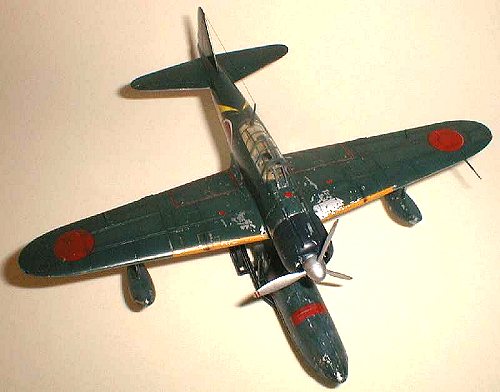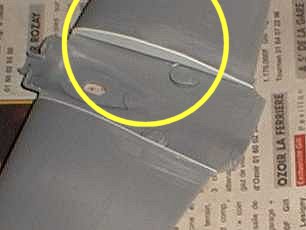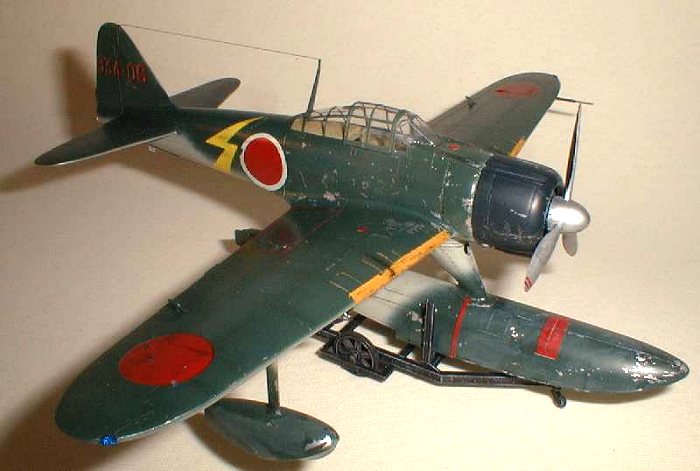
Hasegawa 1/48 A6M2-N 'Rufe'
|
KIT # |
JT 69 |
|
PRICE: |
$25.00 |
|
DECALS: |
See Review |
|
REVIEW : |
Gilles Galvao |
|
NOTES: |
Translation by Sebastien Privat |

|
HISTORY |
 The Rufe history has already been covered in detail, so I wonít bother you
with it once more...
The Rufe history has already been covered in detail, so I wonít bother you
with it once more...|
THE KIT |
This kit uses some parts of the previous Hasegawa A6M2 : we find the parts for
this kit, along with new sprues, with the new
fuselage, the floats, and a whole new lower wing part. There are parts for a
beaching cart, and everything that has been said about Hasegawaís Zero can be
said for this one too. The decal options allow you to build either a grey/green
Rufe from the 934th Flying Group, or an all grey plane from the Kamikawa Maru.
The decals are thin enough and seem to be in register.
|
CONSTRUCTION |
 I began with the cockpit. I painted it using Aeromaster Acryl Nakajima Interior
Green (Translatorís note : the pictures donít look green, but the cockpit is
!), highlighted with a black wash and some dry brushing. The holes in the back
of the seat are drilled out, but I confess I missed one. The instrument panel
was made using the kit decal, helped in place with a respectable amount of decal
softening solution. I coated the interior with matt varnish before putting a
drop of gloss varnish in the instrument faces. The lap belts are made using tin
foil from a bottle of wine. I voted against over-detailing the interior, of
which little can be seen once assembled.
I began with the cockpit. I painted it using Aeromaster Acryl Nakajima Interior
Green (Translatorís note : the pictures donít look green, but the cockpit is
!), highlighted with a black wash and some dry brushing. The holes in the back
of the seat are drilled out, but I confess I missed one. The instrument panel
was made using the kit decal, helped in place with a respectable amount of decal
softening solution. I coated the interior with matt varnish before putting a
drop of gloss varnish in the instrument faces. The lap belts are made using tin
foil from a bottle of wine. I voted against over-detailing the interior, of
which little can be seen once assembled.
 The fuselage is assembled around the cockpit without fuss. A problem rises
when itís time to join the wings to the fuselage. Thereís a gap at the
junction, along the fuselage. I inserted a plastic card strip, and I cut it out
and sanded it flush, so it became invisible once glued. I then masked the
canopy, and temporarily glued it in place using white glue. I masked
The fuselage is assembled around the cockpit without fuss. A problem rises
when itís time to join the wings to the fuselage. Thereís a gap at the
junction, along the fuselage. I inserted a plastic card strip, and I cut it out
and sanded it flush, so it became invisible once glued. I then masked the
canopy, and temporarily glued it in place using white glue. I masked
the cockpit opening, and gave the model a coat of Modelmasterís Metallizer.
The floats, once assembled, get the same
treatment. Please donít forget to put some ballast in the main float !
|
PAINT & DECALS |
I polished the model using a soft cloth before painting the camouflage
scheme. I chose the 2 tone camoed machine with the
yellow lightning bolt on the fuselage. I began with the IJN grey, then the upper
side with some Nakajima IJN green. I weathered the green using the base color
lightened with grey and heavily diluted, and sprayed the mixture on the center
of the panels. This is the first time I do that, and Iím quite satisfied
with the result.

I glued the floats in place, and enjoyed some very entertaining twenty minutes holding them while the glue was setting. I took some pics and showed them to some modeling friends of mine, and was told the floats were not weathered enough, as the salt traces were lacking. No problem, I went back to my table, and gave the floats a wash of very diluted light grey. As I hadnít any picture of a Rufe, I had to use my imagination instead of my references, and Iíll let you tell me if the result is realistic or not.
At that point, I made the exhaust stains by drybrushing matt black in several passes. I painted the engine various metallic and grey shades and glued it in place. Then came the cowling, the bombs, the propeller, the cannons, the canopy and the exhausts.
Thereís also an access ladder, but as I had forgotten to drill the holes
before assembling the fuselage... Well, no ladder.
I had another funny adventure, when I tried to glue the seat and the gunsight in
place, after assembling the whole model. The seat didnít cause any problem,
but the gunsight slipped between my fingers, and escaped inside the fuselage (no
firewall there !). I shook the model to get it out, but I had put some glue on
it. I finally stopped shaking this thing because I was fearing to get a float
rather than the gunsight. Itís still firmly glued inside the fuselage, so if
anybody has a spare sight, please contact me...
I finished the model glueing the lights, the antenna wire (painted in black,), and off I went to the photo studio ! The cart had been built early, and painted black with a grey drybrush.

|
CONCLUSIONS |
This is a really nice model, and a welcome change on my shelves. I thoroughly enjoyed it, but more the painting part than the building itself. Iím a beginner in weathering, but as the operational environment of the Rufe was rather damaging for the finish, and as the Japanese paints didnít hold well to the metal, I had the opportunity to experiment without fearing to get something really overdone. Anyway, if you like props and are fed up with Messerspitstangs, give this one a try !
You can see more of Gilles' work by visiting his website; http://www.master194.com/
If you would like your product reviewed fairly and quickly by a site that averages over 2,200 visits a day, please contact me or see other details in the Note to Contributors.